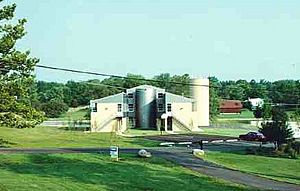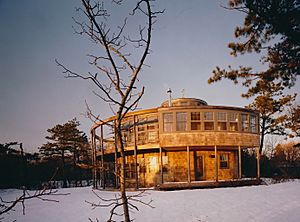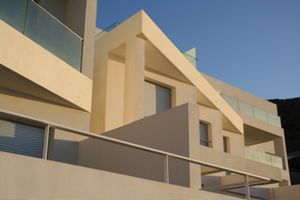Susana Torre facts for kids
Susana Torre (born in 1944) is a famous architect, writer, and teacher. She was born in Argentina and later moved to the United States. She lived in New York City for many years and has been based in Carboneras, Almeria, Spain since 2009.
Susana Torre is known for combining her ideas about architecture with actually building things. She also taught and wrote a lot about design. She made history as the first woman asked to design a building in Columbus, Indiana. This town is famous for its many buildings designed by well-known architects.
In 1977, Susana Torre put together the first big exhibition about American women architects. She also edited a book called Women in American Architecture: A Historic and Contemporary Perspective. This exhibition started at the Brooklyn Museum and traveled all over the United States and to the Netherlands. Her work helped bring attention to the important contributions of women in architecture.
Contents
Early Life and Education
Susana Torre was born in Puan, Argentina. She was the oldest of three children. Her father was an economist, and her mother was a school teacher. When she was eight, her father passed away, and her family moved to La Plata, near Buenos Aires.
She went to public schools there and later studied architecture at the Universidad de La Plata and Universidad de Buenos Aires. She earned her architecture degree in 1968. Before graduating, she represented Argentina at a design conference in Colorado in 1967. She also won a special award that let her travel and study across the United States.
After returning to Argentina, she started the Design Department at the Museo Provincial de Bellas Artes in La Plata. This was the first department of its kind in Latin America. While still a student, she designed an apartment building and a small house for herself.
Starting Her Career in the U.S.
In 1968, Susana Torre came back to the U.S. to study how computers could be used in architecture at Columbia University. In New York City, she worked with The Museum of Modern Art's Department of Architecture. She also worked on a project about new city settlements.
In 1972, Torre began teaching at SUNY at Old Westbury. There, she created the first design courses for the Art Department. The next year, she helped start the Archive of Women in Architecture. This archive led to the important 1977 exhibition "Women in American Architecture."
In 1978, she opened her own company, The Architectural Studio, in New York City. One of her first projects was designing law offices for an art collector. This project was recognized by the American Institute of Architects as one of the most memorable spaces of the 1970s.
Designing Buildings and Spaces
Susana Torre's architectural work is based on strong ideas about how buildings should connect with culture and society. Her designs often bring together cultural, social, and local themes. She has worked on many different types of projects, from book covers to large park proposals.
Her projects include renovating buildings, designing homes, and creating public buildings. Some of her most famous works are Fire Station Five in Columbus, Indiana, and her park idea for Ellis Island, New York Harbor. She also designed homes in The Hamptons, New York, and renovated a building for Columbia University.
Her designs have won awards and have been featured in books and magazines around the world. She was the first woman to win a public design project in Columbus, Indiana. Her Fire Station #5 is listed as one of the key buildings of 20th-century American architecture. In 2008, she finished designing a community of seven beachfront houses in Carboneras, Spain, where she now lives.
Fire Station Five: A Special Design
Susana Torre spent a lot of her career thinking about how buildings fit into their surroundings. She also explored how ideas about women and cultural identity could be shown in architecture. Fire Station #5, finished in 1987, was special because it was the first firehouse designed to include women firefighters.
The design changed how fire stations were traditionally built. It removed large dorm-style sleeping areas and created spaces like the kitchen for firefighters to bond. This new design was later used across the country. It showed how thinking about gender could change a building's layout and overall look.
In 1980, Susana Torre was chosen to represent the United States at a big international architecture exhibition in Italy. Her drawings and projects have been shown in many museums and galleries. Her work is also kept in important archives, including those at Columbia University and Virginia Tech Libraries.
Teaching and Research
Susana Torre has held many important teaching positions. She was the Director of the Cranbrook Academy of Art and led the Architecture Department at Parsons School of Design. She also directed the Architecture Program at Barnard College, Columbia University.
She has taught architecture and urban design at many universities around the world. These include Columbia University, Yale University, and the University of Sydney in Australia. She has also given lectures at over 150 universities and professional groups.
Her teaching style focused on designing buildings that respond to their environment and culture. She also taught about using sustainable materials and how building layouts can show social structures. She encouraged her students to enter design competitions, and they won many awards. Her research often focused on women in architecture, Latin American architecture, and how public spaces hold memories.
Awards and Recognition
Susana Torre has received many awards for her designs and scholarly work. Some of these include:
- The Ailsa Mellon Bruce Senior Fellow award in 2003.
- Awards from The Graham Foundation in 2002.
- Awards from The National Endowment for the Humanities in 1986 and 2005.
- The American Institute of Architects New York Chapter award in 1994.
- The Fulbright Senior Scholar award in 1990.
- Awards from The National Endowment for the Arts in 1973, 1979, 1986, and 1990.
- The Architectural Record Houses Award of Excellence for Design in 1981 and 1988.
Selected Writings
Susana Torre has written many important articles and books. One of her most well-known works is the book Women in American Architecture: A Historic and Contemporary Perspective, which she edited and wrote parts of. This book has been translated into Dutch and Spanish.
She also wrote essays like "Building Utopia: Mary Otis Stevens and the Lincoln MA House" and "The Elusive Unifying Architectural Discourse: Teaching Architectural History in Latin America." Her writings often explore cultural identity, public spaces, and the role of women in architecture.
See also
 In Spanish: Susana Torre para niños
In Spanish: Susana Torre para niños






